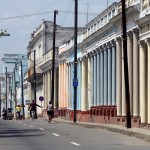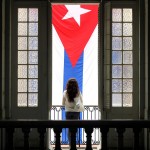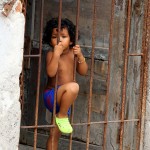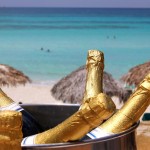Cuba
Cigars, Rum, Castro, Che, Classic Cars, Neglect & Salsa. The Indefatigable Caribbean Time Warp & A Country Truly Like No Other
Centro, Havana, Cuba. April 30, 2015
Cuba
 It seems everyone is buzzing about Cuba these days. It’s the place to be, the next big must-see location, and it was that even before the recent and on-going thaw in Cold War-ear hostilities between it and the big bad US only some 150 kilometres (93 miles, America) away north across the Florida Strait. ‘Go see it now before it changes forever’ is the advice, as if it’s likely to. It’s not. Cuba has been stuck in something of a tropical deep-freeze ever since the Cuban Revolution of 1959, one that inadvertently saved many endangered traditions, and it’s going to need more than a massive influx of new tourists & their money to put a visual dint in all the faded grandeur on display today, most famously the crumbling colonial architecture & the lumbering 1950s classic cars that are somehow still plying the country’s signage-challenged roads. Cuba, the largest island in the Caribbean, is too visually & culturally complex, too beguiling, just too damn vast. And after not changing at all for over half a century, it’s hardly going to change with any kind of urgency now, new money and new opportunities notwithstanding. Change is coming, of course it is, but I suspect Cuba will still fascinate on so many levels even when it does.
It seems everyone is buzzing about Cuba these days. It’s the place to be, the next big must-see location, and it was that even before the recent and on-going thaw in Cold War-ear hostilities between it and the big bad US only some 150 kilometres (93 miles, America) away north across the Florida Strait. ‘Go see it now before it changes forever’ is the advice, as if it’s likely to. It’s not. Cuba has been stuck in something of a tropical deep-freeze ever since the Cuban Revolution of 1959, one that inadvertently saved many endangered traditions, and it’s going to need more than a massive influx of new tourists & their money to put a visual dint in all the faded grandeur on display today, most famously the crumbling colonial architecture & the lumbering 1950s classic cars that are somehow still plying the country’s signage-challenged roads. Cuba, the largest island in the Caribbean, is too visually & culturally complex, too beguiling, just too damn vast. And after not changing at all for over half a century, it’s hardly going to change with any kind of urgency now, new money and new opportunities notwithstanding. Change is coming, of course it is, but I suspect Cuba will still fascinate on so many levels even when it does.
– Lonely Planet Cuba
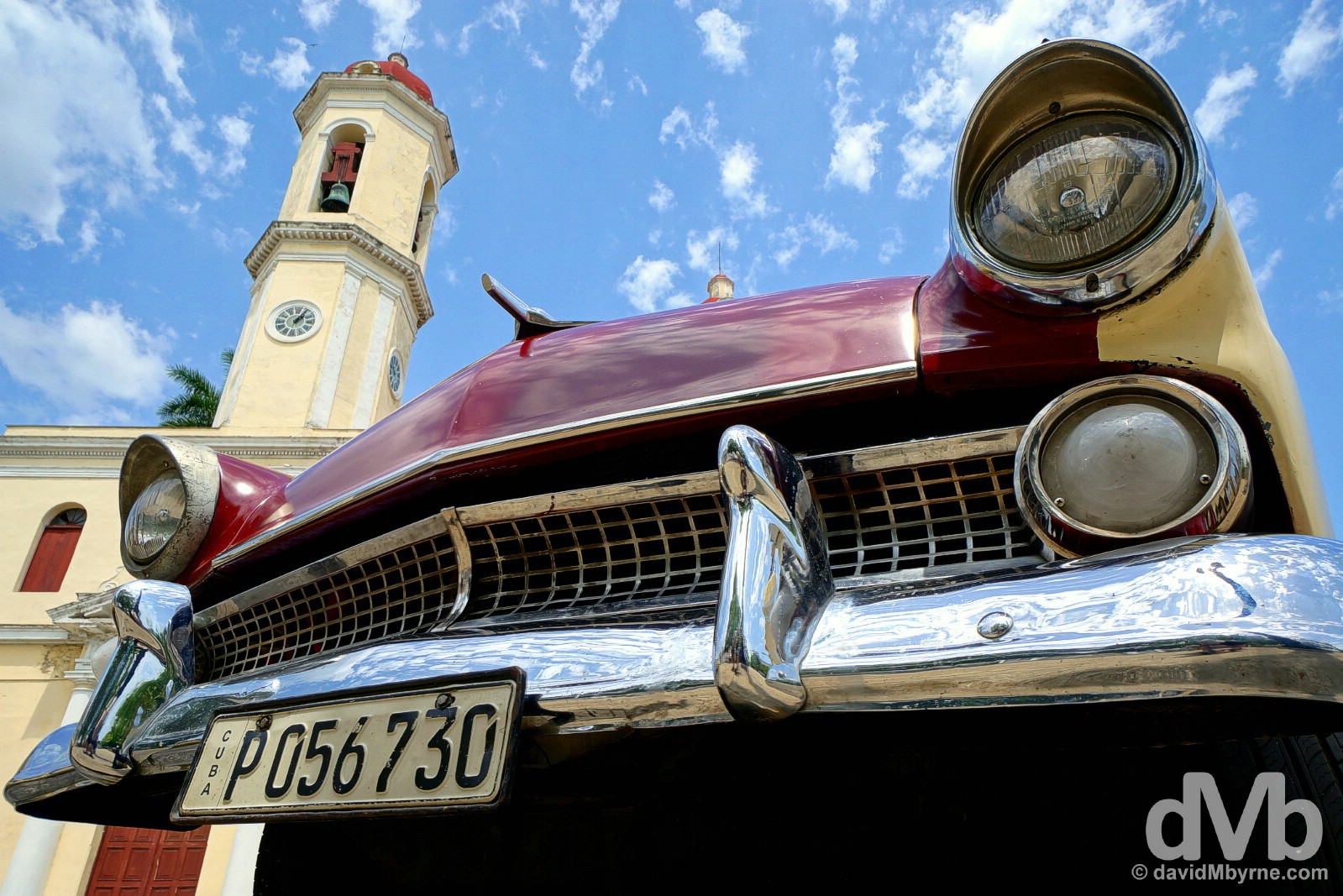
A Classic. Car & City. Cienfuegos, Cuba. May 8, 2015.
HISTORY & A CHANGING CUBA
– Christopher Columbus upon nearing Cuba on October 27, 1492

Pre-1959 || Pre-Columbian & Colonial Cuba
Prior to European contact in 1492 Cuba was principally inhabited by the indigenous Tainos, the first pre-Columbian culture to nurture the tabaco plant so that it could be processed for smoking. Spanish colonialism shortly followed, a period officially lasting from 1511, with the landing of the first colonizers led by Diego Velazquez, until 1898. A long & difficult period for the island but one that has shaped it to this day, during this time Spanish conquistadors came, saw, conquered, ruthlessly ruled, built & enslaved; first introduced into Cuba in 1522, there were some half a million African slaves in the country by the 1840s when Cuba was the world’s largest sugar producer, reason enough for the sweet-toothed US, who had their eyes on Cuba from as early as 1808, to offer – twice – to buy the island from the Spanish. Disenfranchised by the Spanish power structure, rebellions by landowners in the late 19th century were quelled until Spanish surrender in July 1898, the result of a US Army-led attack on the Spanish in the eastern city of Santiago de Cuba, the only important land battle of the so-called Cuban War of Independence. The US lingered – Cuba was under US military occupation for a further 4 years after the Spanish withdrawal – & ultimately helped shape and usher in a constitution, Cuba’s very first, in 1902, granting Cuba nominal independence. What followed was a unstable period of quasi-independence with a (very) strong American influence – American troops were summoned to the island three times in the first 15 years of the fledgling republic’s existence. Despite some positives, this was a period of violence, corruption, and general governmental dissatisfaction with Cuba stumbling from one US-backed leader to another, the last of which, Fulgencio Batista, conceded power in 1959 to Fidel Castro and his band of handsome bearded revolutionaries, including Fidel’s younger brother Raul, 7 years Fidel’s junior, & a certain Che Guevara. This brought an end to The Populist Revolution, a.k.a. the Castro coup.

Photographing the Prensa Libre, Huye Batista (Free Press, Batista Flees) mural in the Museo de la Revolucion/The Museum of the Revolution, Havana, Cuba. May 2, 2015.
1959 – Present Day || Castro’s Cuba & Change
The post-revolution years saw the new revolutionary government enacting some unpopular reform packages, the cumulative affect of which ultimately saw almost one-fifth of the population emigrating. Relations with the US also deteriorated leading to the first of many embargos imposed by the United States on Cuba coming in October, 1960. US/Cuba relations continued to plummet, not helped by a failed CIA-sponsored invasion of Cuba’s Bay of Pigs in April 1961, while Cuba/Soviet relations prospered, all of which culminated in the Cold War Cuban Missile Crisis of April 1962 when the USSR secretly installed missiles in Cuba & pointed them at the US. To this day it is still the closest the world has yet come to all-out nuclear war. The US travel ban followed in 1963. Economically ostracised, heavily reliant on Soviet aid, & with the pause button on progress firmly engaged, Cuba became a living time capsule (although conversely, educational and healthcare advances enacted during this period of isolation ensured that present-day Cuba has one of the highest literacy rates in the world – 99.9% – and a healthcare system the envy of much richer nations). Life for everyday Cubans was a struggle during the hard-line Soviet days of the ‘70s and ‘80s but the collapse of the Soviet Union in 1991 hit Cuba hard, exasperating an already bleak economic picture and ushering in a period of severe austerity (dubbed the periodo especial). Desperate to find income streams, in 1993 the government did the unthinkable by legalising the US dollar. They also opened up the economy to tourism by building a string of all-inclusive beach-fronting resorts in the Varadero region on Cuba’s Atlantic-facing north coast. Still government-owned today, these resorts, while showing their age, are a lifeline for the Cuban economy. The reforms of resent years continue, drip-fed to a skeptical public. Began in 2008 under new leader Raul Castro, who is far less of a dogmatist than his older brother Fidel, the reforms are slowly granting more and more freedom to everyday Cubans while simultaneously attempting to finally take the sting out of the worst global recession in living memory – Cubans can now buy mobile phones & various other electrical goods (since 2008), their homes (since 2011), & they can travel freely abroad (since 2013). Of course very few can afford such luxuries. For now at least. Needless to say the biggest change of all is likely to come as a result of the improving relations with the US and the cessation, whenever they come, of the crippling commercial, economic, and financial embargos. How the lifting of these longstanding embargos change, for the better or worse, Cuba & the lives of everyday Cubans is anyone’s guess.
CUBA ESSENTIALS
MONEY & TOUTS || In the post-1993 double economy, there are two peso currencies in use, local-only pesos (MN, moneda nacional) & convertible pesos (CUC). Pegged to the US dollar, there are approximately 25 MN to the CUC (US$ = CUC = MN25). This dual currency system has had the effect of reinvigorating the two-tier ‘haves’ & ‘have-nots’ class system that the 1959 Cuban Revolution fought to eradicate. This and the social issues it has spawned (prostitution being just one obvious example) are some of the bigger problems facing modern-day Cuba. Foreigners are expected to buy everything in CUC and will rarely, if ever, handle MN, although they are easily available (a souvenir maybe) in the ubiquitous state-run Casa de Cambios where you acquire CUCs by exchanging much sought-after foreign currency (there’s a 10% fee for exchanging US$). Predominantly a cash-based economy, ATMs are scarce as hen’s teeth outside of the airport. Credit cards are not widely accepted (US-issued cards won’t work anywhere in Cuba).

Cuban pesos, MN, moneda nacional, barely worth the paper they are printed on. I was gifted the 3MN note (worth about €0.11, 8 of these equating to 1CUC or the equivalent of US$1, & sporting that iconic stylised visage of Che Guevara) by David, a curly-haired, pint-sized, hyperactive motormouth & Ronaldinho doppelganger who befriended us on the streets of Havana and led us to a bar in Centro Habana (Central Havana) for some afternoon Cuba Libres. We were hideously overcharged of course but, and all being told, we didn’t really mind; some experiences are everlasting & thus priceless. The green 5MN note was gifted to me by The Poorly Old Man on the streets of Camagüey (see Camagüey below for more).
The government is cashing in on every penny you spend & in a society that on average earns $25 a month, there’s no shortage of friendly locals working an angle to find ways to make extra cash by working with (or over) tourists. Even the non-savvy tourist will notice this.
– Lonely Planet Cuba
Cubans working with tourists are adept at extracting money from foreigners & they do so with a smile and a matter-of-fact confidence that rarely rouses suspicion. The advertised CUC4-6 Cuba libre or mojito will invariably cost more come bill/cheque time, the taxi ride will always seem more expensive than it should be, and you’ll always find yourself tipping the ubiquitous musicians who pop in & out of the restaurants & bars you frequent. You’ll rarely feel taken advantage of – you probably won’t even notice it at the time – but it all adds up. Cuba is still good value but it’s not necessarily the bargain it may first seem. In fact, it can get quite expensive. || GETTING AROUND || While free to venture onto the busy, cramped & stuffy locals-only buses, foreigners are expected to travel by Viazul, the for-foreigners state-run bus company. Tickets can only be purchased at stations. Services are infrequent & not particularly cheap (although a lot cheaper than renting a car, an expensive outlay in Cuba) but there is at least one bus a day between major cities. I never took the train in Cuba & had no reason to fly. Taxis are more expensive than you’d imagine (foreigner rate no doubt) & obviously the better presented the restored 1950s classic is, the higher the quoted fare (always agree in advance). Shiny convertibles will be the most expensive ride of all. || SLEEPING || There are no hostels in Cuba (not yet) & all hotels & resorts are government owned & overpriced/expensive (although the all-inclusive resort deals can be good value, especially for families). Independent travellers bed down in a casa particular. Spanish for ‘private house’, a casa particular is a homestay that rents rooms in a family home to foreigners, much like a B&B. For CUC20-25 a night for a single room & CUC25-30 a night for a double room, they offer an affordable form of authentic cultural immersion. Breakfast is normally provided and evening meals available for an additional fee, typically CUC6-7. While online booking is growing in popularity (see casaparticular.com), and even with the likes of Airbnb getting in on the act, very few casa particulars have an online presence (for now). Ubiquitous in all Cuban towns & cities, they are identified by an unfinished-looking blue logo with the accompanying words ‘Arrendador Divisa‘ (currency landlord) displayed on the outside of the property. Simply knock, smile and be shown to your room. If your casa of choice is full, you’ll more than likely be led by the owner, who pays the government a flat yearly fee/tax to retain casa particular status, to a friend’s property nearby. Likewise, & when leaving one town or city for another, your casa owner may give you details of a friend’s casa in the next town, and might even have them meet you off the bus, as happened with us in Cienfuegos.
– Lonely Planet Cuba commenting on the casa particular
FOOD & DRINK || Beans, rice, chicken & sandwiches. Cuban food is probably the worst in the Caribbean, a region not renowned for its cuisine. Cuba’s contribution to world cuisine is the Cuban sandwich, a bland ham & cheese staple that originated in Cuban communities in the US and somehow found its way back to the motherland. Enough said. Resort food is as plentiful and nondescript as you’d expect from a buffet, the food in restaurants in tourist-frequented towns not much better. The best food is, seemingly, available in high-end hotels and the home cooked dishes lovingly served up by the casa particular host. It seems Cubans put all their efforts into making rum-based cocktails. The classic Cuba Libre (known as a rum & coke outside Cuba) is as simple as it is tasty & the iconic mojito really does cool you down on a hot Cienfuegos afternoon, although rather surprisingly I did find bar staff on more than one occasion somewhat reluctant to muster up a time-consuming mojito. Even at foreigner prices, 1 litre bottles of Havana Club rum are very cheap, dangerously so. For beer your choice is Cristal (a light 4.9% lager) or the more potent (5.5%) Bucanero Fuerte. Neither are great but they get the job done. || INTERNET ACCESS || This is just one aspect of Cuban society that needs to get with the times. It’s probably best to forget the online world for a while. You can get online in resorts and in state run Etecsa Telepunto telecommunication outlets where you’ll queue, your details recorded and internet traffic monitored, but it’ll be expensive (CUC4-6 per hour) and speeds probably not what you’re used to. Of course things are improving all the time and will continue to improve (I hear there’s even Wi-Fi hotspots in some city parks) but for now it’s best to just forgo getting online for the duration of your trip. Save for an hour I spent online in Camagüey, which was an experiment in patience I’d rather not repeat (details below), I was offline for the duration of my time in Cuba and I loved it. || VISA, ONWARD FLIGHT, TRAVEL INSURANCE & DEPARTURE TAX || To enter Cuba you don’t need a visa per se, just a tourist card (Tarjeta del Turista) that isn’t even affixed to your passport (good for Americans to avoid, and until such time as the 53-year-old travel ban is lifted, raising the ire of officials back home as Cuban officials will offer, if you so wish, to stamp the card & not your passport hence leaving no record of a visit to Cuba in your actual passport). These tourist cards are easily available, possibly even at your airport of departure (true for Cancun, Mexico, a popular gateway to Cuba for American travellers). Check. Having a confirmed onward flight wasn’t a requirement for me, and nor was health/travel insurance. I had both but neither was ever requested even though a (non-US) comprehensive travel insurance policy that covers all overseas medical costs, including medical evacuation for the full duration of your stay, is an official Cuban government requirement for all visitors. There is no longer a departure tax. The fee of CUC$25 was scrapped on May 1, 2015 mere days before my May 11 departure from the country and is now included in the cost of the flight ticket.
Discovering Cuba
Varadero, Havana, Santa Clara, Camagüey, Trinidad & Cienfuegos
A former Spanish colony in the steamy Caribbean liberally coloured with French, African, American, Jamaican, and indigenous Taino influences, not to mention heavily shaped by capitalist America for the first half of the 20th century and communist USSR for the second half, it’s a whopping understatement to say that modern-day 21st century Cuba, which is seemingly ready for the challenge of awakening from its multi-decade hibernation, offers up quite the visual contrast. When walking the streets of any Cuban city, looking just like they did in the 1950s but with the added bonus of 6 decades of neglect, it doesn’t take long to appreciate that there really is nowhere else quite like it on earth.

Over half a century of neglect. San Ignacio, Habana Vieja/Old Havana, Havana, Cuba. April 30, 2015.
– Lonely Planet Cuba
I spent almost three weeks being charmed by Cuba. The first portion of my visit saw me passing 6 nights in an all-inclusive resort in Varadero, the country’s insanely popular big resort region that sprung up shortly after the fall of the USSR in the early 1990s in a (hugely successful) bid to find a new source of much-needed foreign cash for the Cuban economy (see HISTORY & CHANGE above). A hangout for the package tourist & full of family-friendly, all-you-can-eat-&-drink government-owned hotels fronting Cuba’s most extensive stretch of idyllic white-sand beaches, Varadero is by far the most popular gateway into the country accommodating as it does the bulk of visitors to Cuba, the majority of which are Canadians; it’s so popular that Lonely Planet provides a 1-week ‘Escape From Varadero’ itinerary to, I assume, entice visitors to see a bit more of Cuba beyond their resort’s buffet bain-maries, poolside bar, sun loungers or tacky nightly stage shows. Visitors who are Varadero-bound are invariably ferried from the airport to their resort & back again. For the vast majority this is all they see of Cuba (which is absolutely nothing of real Cuba), although a few adventurers might just drag themselves away from the confines of the resort for a portion of a day to embark on a whistlestop resort-facilitated ‘Havana Highlights’ tour of the capital, a 3-hour drive west of Varadero.
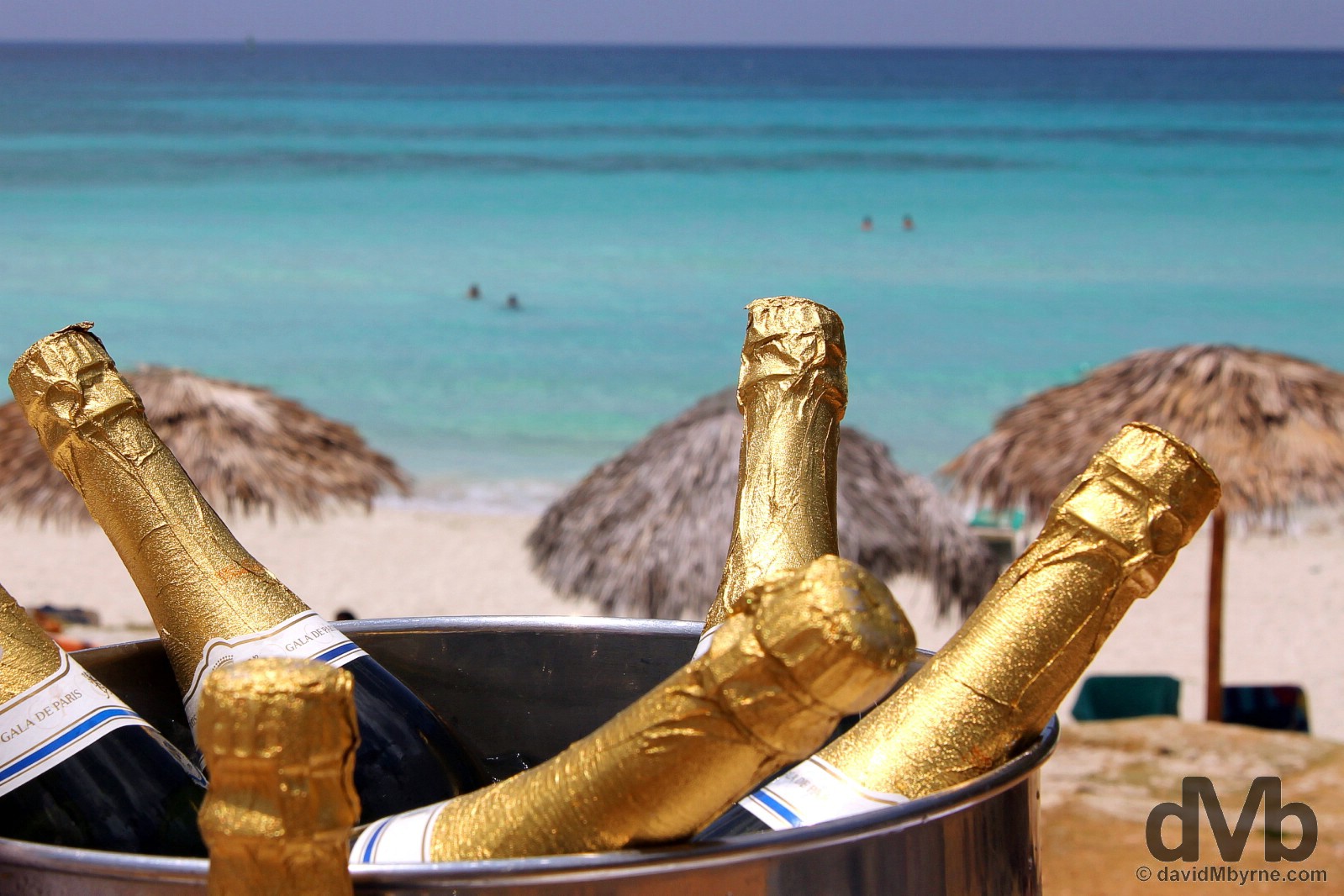
Chris & Liane’s wedding. Breezes Bella Costa resort, Varadero, Cuba. April 27, 2015 || I visited Varadero for a wedding. Good days with good people and an enjoyable, albeit blurry, rum-fuelled start to my time in Cuba (& the greater Caribbean).
While it ably welcomes all & suits most, Varadero is hardly an authentic look at a country that outwardly hides very little. I was pumped to leave the resort and embark on some independent travel around Cuba. And when I did I spent 11 days visiting the beating & pealing capital of Havana; the labyrinth of narrow streets that is Camagüey; the unblemished colonial townscape of the old sugar town of Trinidad; & Cienfuegos, a beautiful French-flavoured bayside city and my favourite location in Cuba. What follows is a typical visual & insight-heavy recap of my time in Cuba, my first but by no means last visit to this extraordinary country.
Cuba Locations Map
Read all Cuba location postings in chronological order or jump to specific postings using these links.
Havana || Santa Clara & Che Guevara || Camagüey || Trinidad & Playa Ancon || Cienfuegos
Caribbean Island Hopping || Onward to Grand Cayman, Cayman Islands
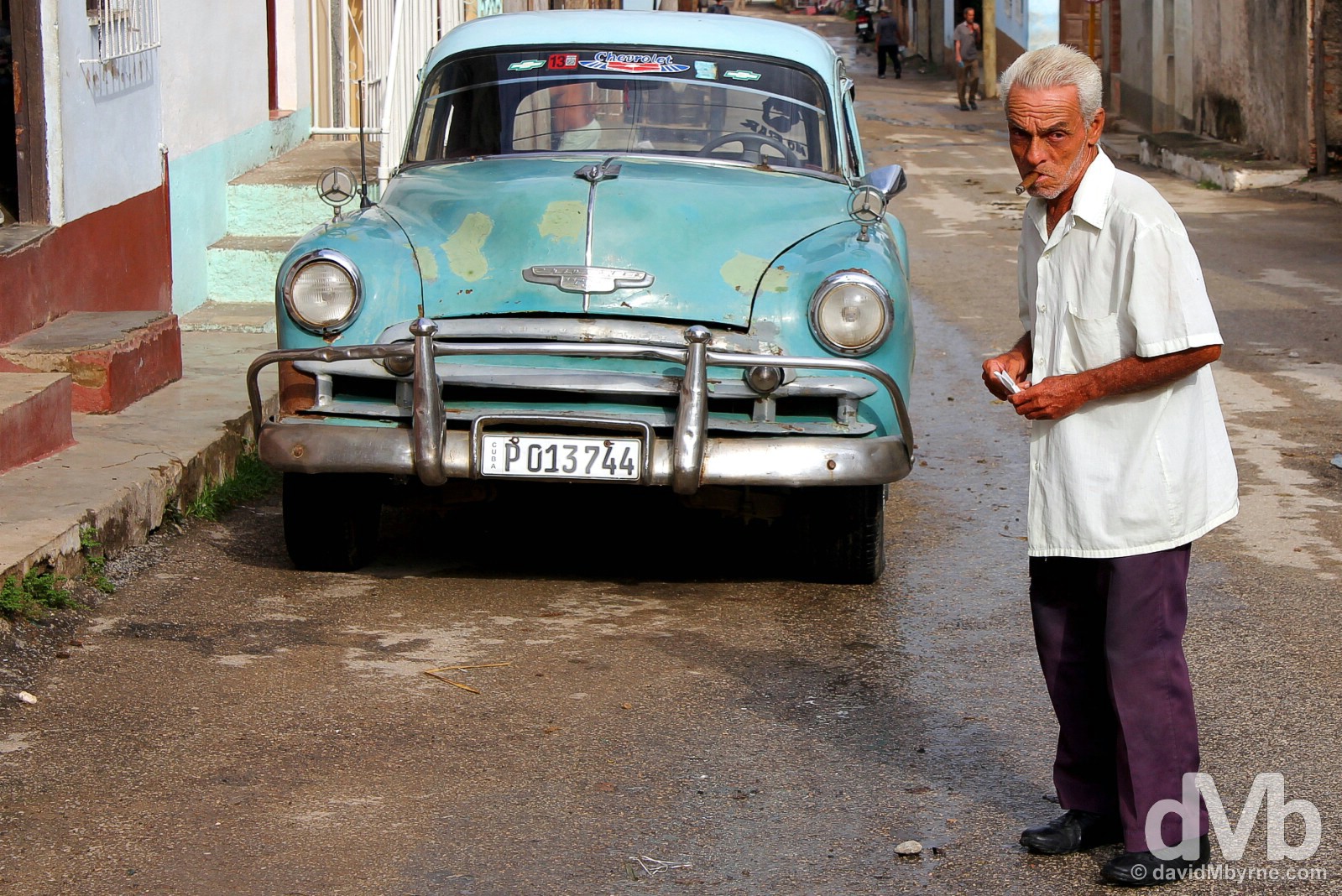
Classic Cars & Cigars. Classic Cuba. On the streets of Trinidad. May 6, 2015.
– Autenticacuba.com
Havana
El Capitol || Filthy, vibrant & downright addictive. A city of myriad streets lined with everything from crumbling, neglected colonial & art deco gems to UNESCO-listed restorations & all pulsing with local life.
The sounds of salasa, car horns, propositions, trundling Cadillac’s, & unseen life emanating out of residential doorways & windows. The smell of petrol, must, cigar smoke, heat, Mojito mint & Cuba Libre limes. The overwhelming sight of faded grandeur and all those classic cars belching out black smoke, reminiscent of a simpler time when no one gave a second thought for the environment. Those are my abiding memories of Havana. Founded in 1519 as the most westerly of 7 founding colonial Spanish settlements & declared the capital of Cuba in 1607, this is the largest city & my first stop proper in the Caribbean. And what an introduction to the region it was.

Iconic Cuba. A soviet-era taxi & a line of seemingly impossibly restored museum piece 1950s American classic cars on Prado (Paseo de Marti) in Centro Habana (Central Havana), Cuba. April 30, 2015.
My taxi from Varadero dropped me off in Parque Central. Just me, my bags, the rain, the steam and the city of Havana buzzing all around me. Emerging from under cover of the park’s many palm trees and delving into the streets of Centro Habana (Central Havana), I found my Casa Particular (a Cuban homestay which rents rooms to foreigners… see CUBA ESSENTIALS above) of choice full, meaning the overly hospitable owner walked me through the streets to an alternate. ‘Gracias’ was all I could embarrassingly muster, reminding me that I had best brush up on my Spanish, and quickly too. It was late in the day but I was promptly out on the streets again armed with my camera and a mental map of how to find my tiny casa particular door on the repetitive grid of disorientating streets that is Centro.

Snoozing on a weathered section of Prado (Paseo de Marti), the city’s stately European-style boulevard in Centro Havana, Cuba. April 30, 2015.
Centro Habana (Central Havana)
Just like the rest of the country, Havana’s infrastructure has suffered through half century of economic stagnation since the 1959 Cuban Revolution. Nowhere is this more evident than in the heart of Centro Habana, one of the capital’s 15 boroughs and somewhere not too many tourists venture, drawn instead to Habana Vieja (Old Havana). A mostly residential area of dilapidated buildings with the sound of everyday life emanating from behind pealing doorways and barred windows, it’s a fascinating place to explore, and when you do eyes, especially young eyes, will be on you.

Behind bars in Centro Habana, Cuba. May 1, 2015.
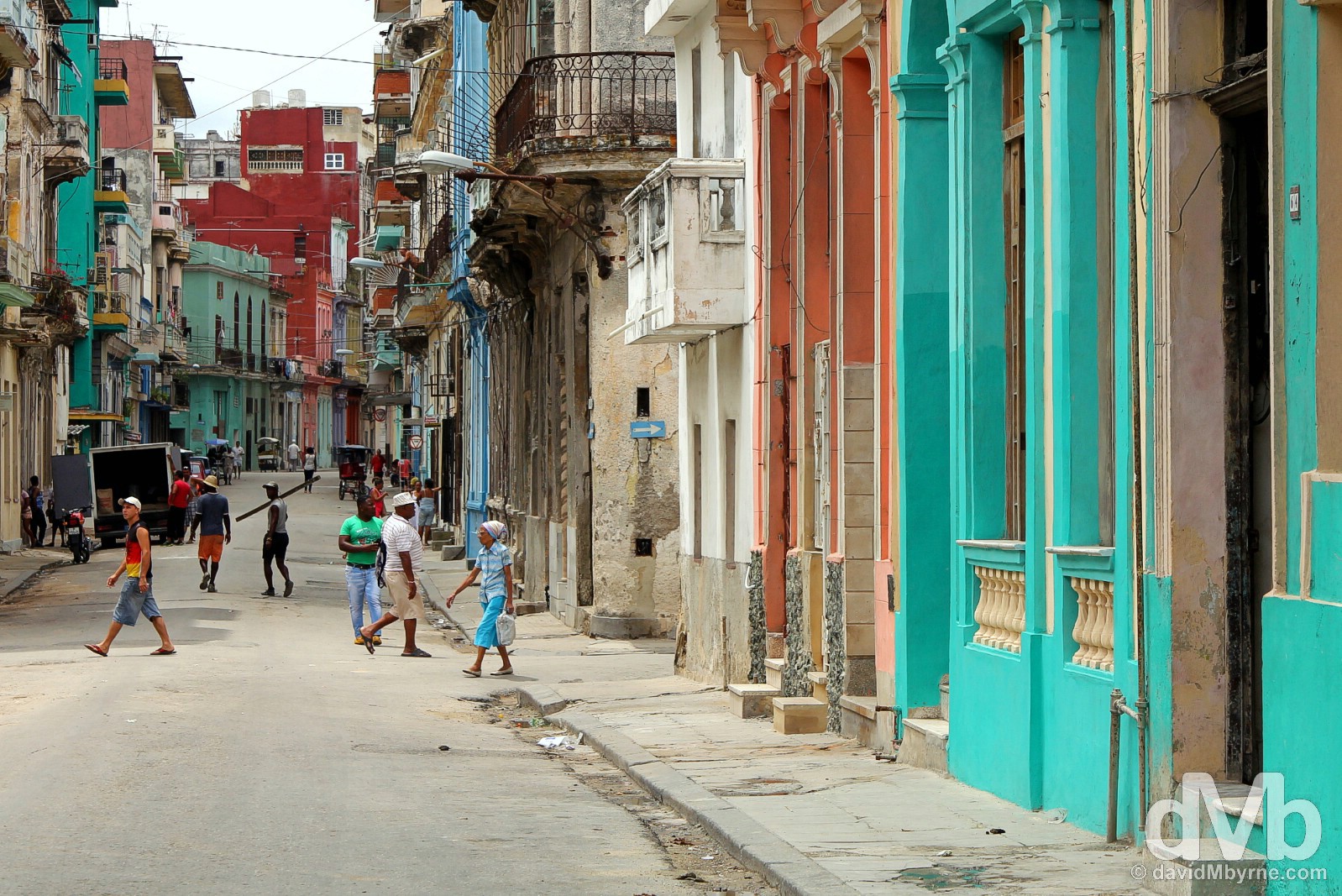
Centro Habana, Cuba. May 1, 2015.

A section of the facade of the Gran Teatro de la Habana & the scaffold-covered central dome of the Capitolio Nacional. April 30, 2015. || Centro isn’t all decay & disintegrating urban beauty. It’s also home to two of Cuba’s most famous and grandiose buildings, the pre-revolutionary Capitolio Nacional, a.k.a. El Capitolio, & the Gran Teatro de la Habana. Constructed over a three year period in the late 1920s with funds from Cuba’s sugar boom days, El Capitolio, bigger but strikingly similar in appearance to the US Capital Building in Washington DC, was once the seat of the Cuban Congress but since the Revolution of 1959 it has housed the Cuban Academy of Sciences and the National Library of Science & Technology. Constructed with white limestone & granite, the building’s main feature is its towering 62 metre-high stone cupola, presently boasting an ugly skin of scaffolding as part of an ongoing renovation of the whole building, one that means Havana’s finest building is presently a bit of an eyesore & off-limits to the likes of me. Recently finished undergoing a restoration of its own, the neighbouring architecturally splendid, 2000-seat Gran Teatro de la Habana opened in 1838 making it the oldest operating performance theatre in the Western hemisphere.
– Lonely Planet Cuba

Outside the Gran Teatro de la Habana on Prado (Paseo de Marti) in Centro Habana, Cuba. April 30, 2015.
Day two in Havana was May 1st, Día de los trabajadores (International Workers’ Day), or as it’s known in Cuba, Día del Trabajo (Labour Day). It’s a half-day celebration with people marching in the streets from early morning in a show of support to their local socialist government and the Cuban Revolution. I watched the joyous festivities on TV while having breakfast with my casa particular family, the grainy TV one of the few trappings of 21st century consumerism visible anywhere throughout the house. People shown on the broadcast were decked out in Cuban colours & were delirious, the miserable conditions aside – it was a very wet start to the day. Once my hosts were done educating me as to the festivities and their whereabouts, Havana’s Plaza de la Revolucion (Revolution Square), I was on the streets once again briskly making my way to the plaza and commenting on my good fortune to happen to be in the city on such a day. Unfortunately by the time I reached the plaza, a 40-minute walk from my casa particular, the celebrations had ended, the grandstands already disassembled, the TV crews gone and the plaza fast emptying of revelers. A missed opportunity no doubt but at least the rain had abated for the rest of my explorations of the Vedado district of the city that I now found myself in.

The iconic Che Guevara mural on the Ministerio del Interior building off Plaza de la Revolucion/Revolution Square in Vedado, Havana. May 1, 2015. || The centerpiece of Vedado, Havana’s early 20th century ‘new city’, is the gigantic Plaza de la Revolucion, Cuba’s de facto large-scale political rally & gathering point. Laid out in the 1950s prior to the 1959 Revolution, when it was called Plaza Civica, to commemorate national hero José Martí, it is surrounded today by a string of ugly, boxy buildings, mostly governmental departments; the guards here can get mouthy. Aside from the square’s unmissable, star-shaped, 142 metre-high Memorial José Martí, the plaza’s most defining feature is probably the huge mural, a stylised visage of Marxist revolutionary figure Che Guevara, with the words Hasta la Victoria Siempre (Always Toward Victory) emblazoned underneath, on the facade of the Ministerio del Interior building. A modern-day worldwide pop culture icon of rebellion, the mural is a copy of a 1960 photograph of Guevara taken by Cuban photographer Alberto Korda. This was the first sighting of this iconic symbol of Cuba that I was to see in the country. Needless to say it wasn’t to be the last. (See more on Che Guevara below as posted from Santa Clara, a.k.a. Che City.)
Vedado
Once a forest reserve, Vedado, meaning ‘forest reserve’, developed in the late 19th & early 20th century as a residential suburb for Havana’s moneyed. Breezy & open, it couldn’t be any more different to cluttered Centro. The city’s commercial hub favoured by business and the political elite, the vast suburb stretches from Plaza de la Revolucion north to Havana’s famous sea-whipped Malecon and the waters of the Florida Strait, a once-notorious Mafia-run district replete with hotels, restaurants and a pulsating nightlife.

En route from Plaza de la Revolucion to the Malecon. A residential street scene in Vedado, Havana, Cuba. May 1, 2015.
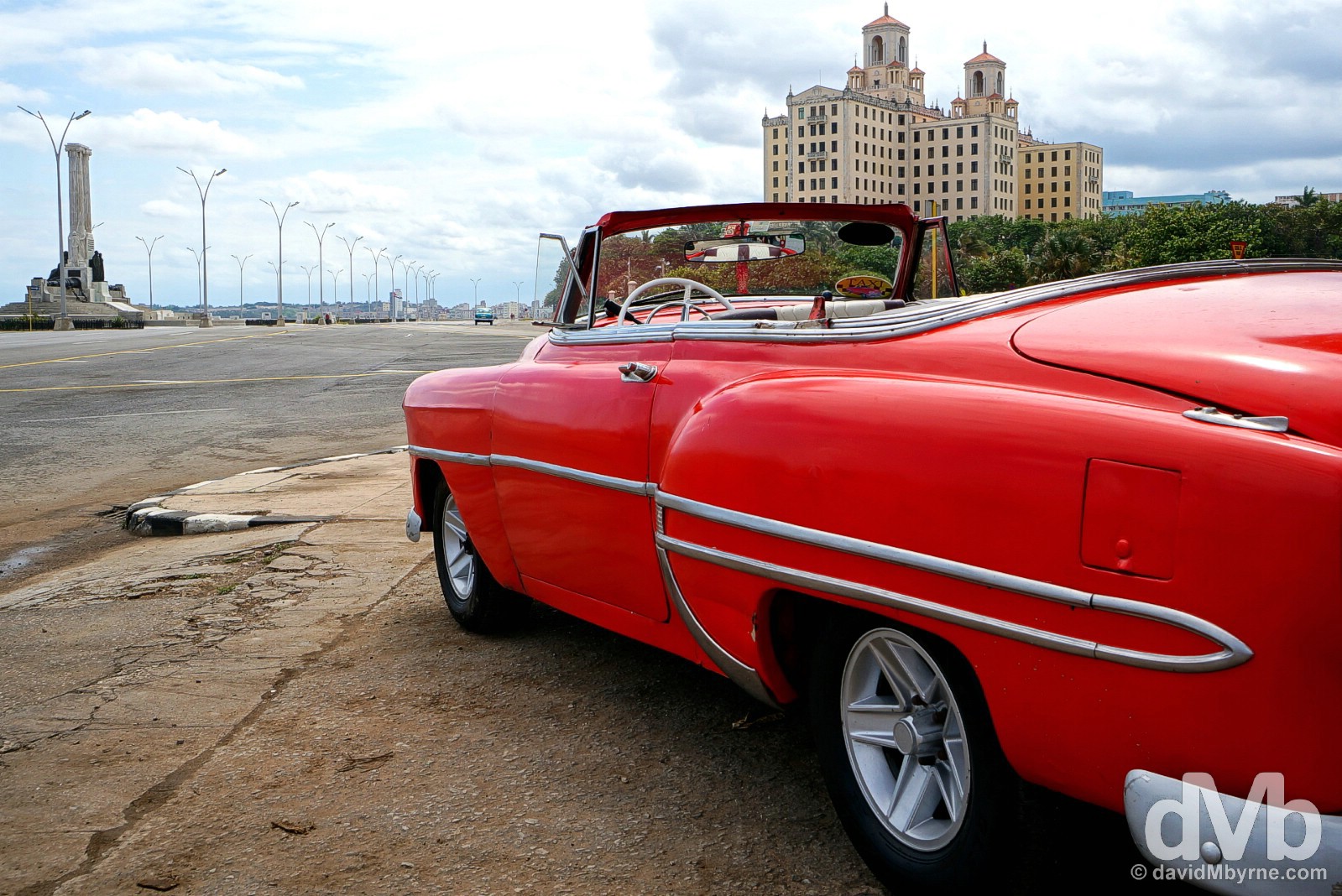
Down by the Malecon in Vedado, Havana, Cuba. May 1, 2015. || The newest part of ancient Havana, constructions in this northern portion of Vedado were heavily influenced by Cuba’s close relationship with the US in the first half of the 20th century. The most obvious example of this is seen in the distance, the eclectic art deco cum neoclassical twin-turreted Hotel Nacional. An historic luxury hotel & city postcard sight (I had a snoop around), it was built in 1930 as a copy of the Breakers Hotel in Palm Beach, Florida. While Havana itself was a favoured hangout of US Prohibition-dodging gangsters, the Vedado district in particular was a popular prerevolutionary gambling mecca. The Hotel Nacional, which boasted a Vegas-style casino back then, gained notoriety in December 1946 by hosting the largest ever get-together of the US Mafia, gathering under the guise of a Frank Sinatra concert. The Vedado hedonism stopped for good in 1959 when Fidel and his band of bearded rebels rolled into town, sending the mob back to Miami and closing down all casinos.
Malecon
Laid out in the early part of the 20th century as a ocean-side boulevard, Havana’s famous Malecon is an 8 kilometre-long, six lane-wide sea drive of shabby magnificence that has long been a favoured hangout for fishermen, wistful Florida-gazers & romance-seeking locals, but these days it draws just as many wave-dodging, camera-toting tourists.

The wave-bashed Malecon in Havana, Cuba. May 1, 2015. || Some of Havana’s most recognisable edifices are seen from this position on the Malecon, looking along the Malecon seawall towards the mid-20th century high rises of Vedado. To the left of the aforementioned Hotel Nacional, and towing over all around it, is the hideous-looking green-&-white FOCSA Building. Built in 1956, the mostly residential hulk is, at 121 metres high, Cuba’s tallest building (and it might also be its ugliest despite being considered one of the seven wonders of Cuban civil engineering – in an era when concrete construction of buildings more than 18 storeys tall was considered unaffordable, the 39-storey FOCSA was only the second project of its kind in the world). Finally, to the left of the image is the also aesthetically-challenged Hotel Habana Libre, another city icon. The classic modernist hotel was opened as the Havana Hilton in 1958 but was commandeered by Castro’s revolutionaries, who used the hotel’s luxury 24th floor suite as a command centre, only 9 months after it opened, promptly renaming it Habana Libre (Free Havana) in the process. Today the lobby of the hotel, whose defining feature is a massive blue Venetian tile mural adorning the front of the building, displays a gallery of images captured at the time, a fascinating collection showing the bearded gun-toting rebels making themselves at home in the spanking-new hotel in January 1959.

The wave-bashed Malecon in Havana, Cuba. May 1, 2015. || Buildings that line the Malecon, which is often closed to traffic at times of rough seas, battle the decaying process on two fronts having also to deal with the corrosive effects of seawater. As a result, many of the buildings, and despite some of them being granted special status by city officials in a bid to preserve them, are in a severe state of disrepair. To some this just adds to the Malecon’s tumble-down appeal.

Sitting on the walls of the Malecon fronting Castillo de San Salvador de la Punta in Havana, Cuba. April 30, 2015. || As the primary Spanish port in the Caribbean & the annual congregation point for Spain’s Caribbean treasure fleet on their way back from the New World, Havana was a dangling carrot for pirates in the 16th and 17th centuries who regularly scourged the city. Today the legacy of past battles can be witnessed in a cache of well-preserved forts all over Cuba; Havana alone boasts four of the finest examples of 16th century military architecture in the Americas, all remarkably preserved in their original state and all UNESCO World Heritage sites along with Habana Vieja (Old Havana). Castillo de San Salvador de la Punta, marking one end of the Malecon, is one of two forts guarding Havana harbour. Construction began in the 1580s but the fort wasn’t actually completed until the 1620s. Built with thick walls in a polygon layout designed to fit with the coastal topography, the fort, like all Cuban forts, was built to last and last it has.
– UNESCO commenting on Habana Vieja (Old Havana) & and its Fortification System
Habana Vieja (Old Havana)
The highlight of Havana for many, and shockingly the only district of the city some choose to visit, Habana Vieja is a Havana’s atmospheric historic masterpiece, a UNESCO-listed treasure chest of eclectic architecture, plazas, cobbled streets, museums & churches. Havana is a wildly exuberant place where music and melodies are ubiquitous on its busy and atmospheric streets. This is especially evident in Habana Vieja where music and dance spills out of bars, impromptu salsa sessions spring up on street corners, a passionate troubadour is never too far away, & where restored cobbled streets stage many an oh-so photogenic peso-seeking four-piece.

Musicians on pedestrian-friendly Calle Mercaderes (Market Street) in Habana Vieja (Old Havana), Havana, Cuba. May 2, 2015.
With the aid of the tourist dollar, much of Habana Vieja has been painstakingly restored from near ruins in recent years. A rather compact district that still manages to house nearly 1000 buildings of historical importance centered around not one but four plazas, Habana Vieja is a rewarding but typically busy place to amble given its undeniable status as Cuba’s most famous attraction and most visited location – even those escaping the all-inclusive resorts of Varadero for a day invariably end up here.

Plaza de la Caterdral, Habana Vieja (Old Havana), Havana, Cuba. May 2, 2015. || Presiding over what is probably the most well-known of Habana Vieja’s 4 plazas is Cuba’s most famous church, Havana’s asymmetrical, double-towered Cuban baroque (like the rest of the plaza) cathedral which dates from the 1700s but which was only elevated to cathedral status in 1788. The cathedral’s locked status (I passed it a few times over a few days and it was never open) meant I didn’t get to see inside.

Restored buildings overlooking Plaza Vieja in Habana Vieja (Old Havana), Havana, Cuba. April 30, 2015. || The 1996 restoration team did a hell of a job on Habana Vieja’s Plaza Vieja (Old Square), the district’s most architecturally eclectic & colourful space; it’s surrounded by an array of colourful facades, some of them boasting Havana’s finest stained-glass windows. Most of the buildings here were constructed as private residences rather than municipal buildings, housing some of Havana’s wealthiest families. Still somewhat residential today, this tourist magnet boasts many an inviting cafe (& even a micro-brewery) and is a great place to just sit, sip and just watch the Habana Vieja world go by.

Looking down Teniente Ray from just off Habana Vieja’s Plaza Vieja towards the unmistakable hulk of El Capitolio in Havana, Cuba. April 30, 2015.
Museo de la Revolucion (Museum of the Revolution)
Havana is awash with museums, especially in Habana Vieja; they are everywhere. However, Havana’s, and maybe even the country’s preeminent museum is the impressive Museo de la Revolucion.

Worshiping the flag in the central courtyard of the Museo de la Revolucion (Museum of the Revolution), Havana, Cuba. May 2, 2015.
Housed in the former Presidential Palace (built between 1913 and 1920), Cuba’s most comprehensive museum doesn’t just deal with the story & protagonists (Fidel, Che, Raul, Cienfuegos etc.) of the 1959 Revolution – when handsome bearded guerrillas meting out Robin Hood-style justice beat the odds – but it also covers all things Cuba right from pre-Columbian times through to the propaganda-heavy, chest-beating displays depiction the benefits of the present-day socialist regime.
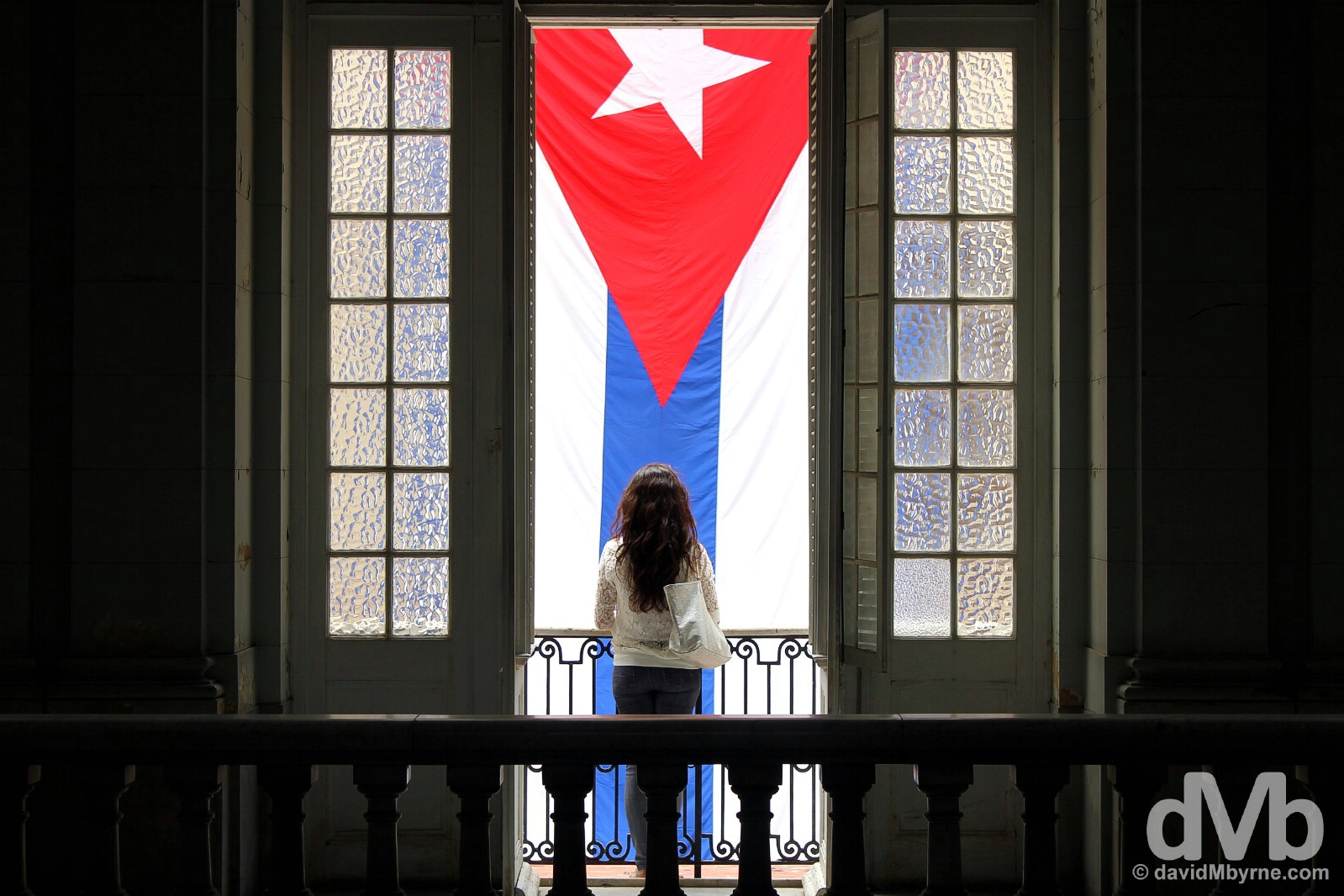
Museo de la Revolucion (Museum of the Revolution), Havana, Cuba. May 2, 2015.
Santa Clara
Che City || A cultural, trendsetting, edgy, gritty student city that is a rite of passage for Che Guevara pilgrims.
I only passed through Santa Clara. Twice. Once through its airport & once through its bus station when breaking the 9-hour Viazul bus journey from Havana to Camagüey. Most travellers do (pass though) given the city’s importance as a junction for cross-country travel; it sits in the geographical dead centre of the country. It’s also something of a Cuban trendsetter, a cultural, edgy, gritty student city that is a rite of passage for Che Guevara pilgrims; the city is home to his mausoleum (but little else of interest to travellers), an open-air museum cataloging his life, and the historic site where in December 1958 he orchestrated the ambush of an armored train during the Cuban Revolution, liberating the city in the process & effectively marking the end of the corrupt pre-revolutionary Batista regime. Yes, Santa Clara, a.k.a. Che City, is all about Che and you don’t even have to leave the bays of the city’s very blue bus station to come face-to-face with that now iconic Che stare, a widely reproduced version of a 1960s picture of Guevara by Cuban photographer Alberto Korda.

Hasta la Victoria Siempre (Always Toward Victory). Che. Killed in 1967, reburied in Santa Clara in 1997 & still to this day revered as an enduring symbol of revolution, nonconformity & Third World freedom. Waiting on the bus to Camagüey in the bus station in Santa Clara, Cuba. May 3, 2015.
ERNESTO “CHE” GUEVARA || EL CHE
Ernesto “Che” Guevara was born in Rosario, Argentina in June 1928 and is of – begorra – Irish & Spanish descent; Guevara’s father, whose family name was Guevara Lynch, can trace his Celtic roots back to Patrick Lynch who was born in Galway, Ireland, in 1715, and who emigrated to South America in 1749. On his travels in early life, the physician-turned-revolutionary was exposed to the grinding poverty and stark political injustices in US-influenced mid-20th century Latin America. This caused him to both embrace Marxism & develop a deep-rooted hatred for the US, not to mention the firm belief that such social inequalities as he saw them could only be solved by violent uprising, not dialogue. A meeting with a like-minded Fidel Castro in Mexico City in June 1955 sealed his place in history: Guevara joined the Cuban revolutionaries as a medic; was quickly elevated to Comandante, one of Fidel’s trusted generals & his second-in-command; orchestrated the liberation of Santa Clara during the Cuban Revolution, effectively sealing an historic revolutionary victory; was granted Cuban citizenship in February 1959, a month after the Revolution; & played a leading economic role in the early days of post-revolutionary Cuba (& a military one by helping to train the militia forces who repelled the CIA-sponsored Bay of Pigs Invasion in April 1961). Never fully abandoning his revolutionary ways, he turned up in Bolivia in the mid-1960s leading a small band of guerrillas against US interference in that country. Eventually captured by the CIA-backed Bolivian army, he was summarily executed in the presence of US advisers in the Bolivian mountains in October 1967. Buried in a secret mass grave, it was 3 decades later, in 1997, that is body was returned to Cuba for reburial at his mausoleum here in Santa Clara.
Camagüey
The Black Sheep || The aloof Cuban rule-breaker & it’s holiest town with a UNESCO-listed core built on a unique labyrinth grid of narrow warrenlike streets which boast a profusion of architectural styles.
Initially founded in 1514 as one of the 7 founding colonial Spanish settlements, Camagüey is Cuba’s third largest & holiest city – it’s the bastion of the Catholic Church on the island. A perennial rule-breaker that grew up somewhat isolated between bigger Havana to the west & Santiago de Cuba to the east, Camagüey was ultimately founded on street grid system unlike any other in colonial Latin America. The city was moved twice to avoid the attentions of pirates, its streets redesigned in a peculiar pattern designed to confuse would-be invaders and to discourage repeat attacks by the likes of Henry Morgan.

Camagüey, Cuba. May 4, 2015.
Camagüey is home of the largest historic centre in Cuba, a well-preserved collection of alluring architecture & cosmopolitan charm that was granted UNESCO World Heritage status in 2008, the most recent Cuban addition to the list.
– UNESCO commenting on the Historic Centre of Camagüey

Camagüey, Cuba. May 4, 2015.
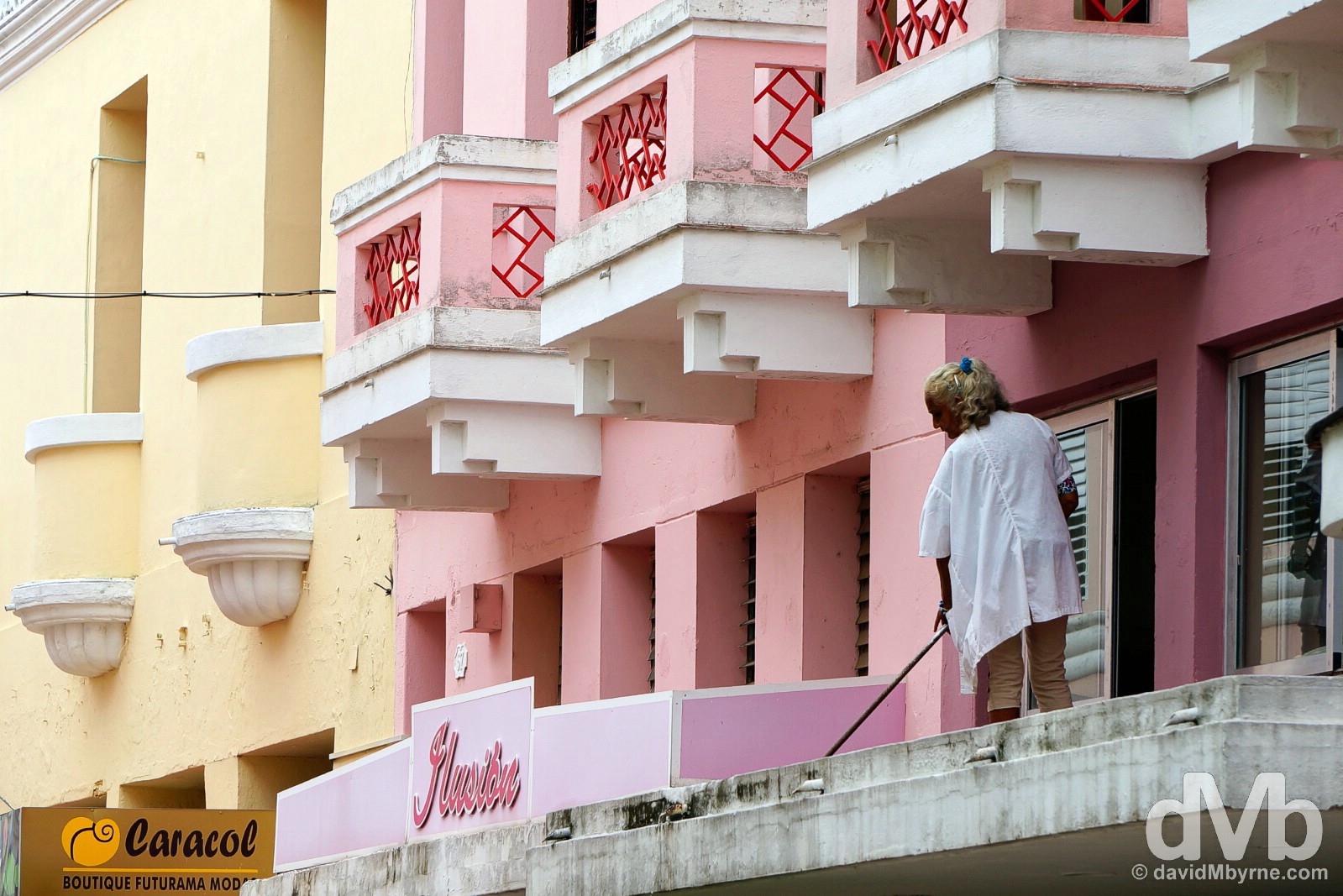
Tending to the colourful architecture lining Maceo, Camagüey, Cuba. May 4, 2015.

Camagüey, Cuba. May 4, 2015.

Yes, of course he’s here too. Che overlooking Plaza de los Trabajadores, Camagüey, Cuba. May 4, 2015.
Cubanos || Personal Camagüey Memories & Highlights
Needless to say, exploring the labyrinth of narrow warrenlike streets that is Camagüey was an adventure. But I have so many other memories of my time in the city beyond its streets full of churches, triangular plazas, colourful & varied architecture, & giant tinajones (clay pots), decorations today but reminders of an earlier time when they would capture & store rainwater for use during the water shortages that often blighted the city. Camagüey was were I, and much more so than in Havana, interacted with everyday Cubans with each & every interaction proving a highlight. Make no mistake, it’s the Cubans themselves, survivors & improvisers each and every one, that are the undisputed highlight of this wonderful country.
• The Ladies || Being extremely popular with the ladies frequenting the city’s Bar El Cambio. Prostitution, and as I was fast discovering, is rife in Cuba, male moneyed foreigners an obvious target.
• The Pianist || Watching our casa particular host beaming with pride as her 8-year-old son impressed Liam, my Cuban partner in crime, & I on the piano after breakfast.
• The Boys || Drinking beers in the presence of friendly, good-humoured but hard-nosed locals in some barren stand-up corner dive bar/café on a typically narrow Camagüey street as the rain pelted down outside.

Republica, Camagüey, Cuba. May 4, 2015.
• The Queuers || Learning how Cubans queue (by shouting “el último”, meaning “the last”) while standing in some semblance of an ordered gathering for hours outside the city’s state-run Etecsa Telepunto on pedestrian Republica, handing over my passport & paying CUC$6 (€5.5) to get online for an hour, the only time I subjected myself to that in Cuba. (It was surprisingly easy and unexpectedly gratifying to be offline for the duration of my time in the country. For more about internet access in Cuba, see CUBA ESSENTIALS above.)
FACEBOOK POST FROM CAMAGUEY || MAY 4, 2015
I´ve been in Cuba for 9 days now with another week to go. It has been, and will no doubt continue to be, amazing. Getting online, something we take for granted in the West, is an (expensive) chore so this will probably be the only time I´ll spend half a day queuing to sit in an internet cafe, something I haven´t done when travelling in about 7 years, for the purposes of telling my nearest and dearest that I´m still alive and to briefly see what´s going on with the rest of the planet. More to come from Cuba in due course, but only when I rejoin the real world.
• The Poorly Old Man || Being befriended on the streets by an elderly man who somehow, and despite the obvious language barrier, conveyed to us the hardships & expense he endures by regularly travelling to a nearby city for medical treatment (we think that was the gist of it). He gifted us (effectively monetarily worthless) Cuban local-only peso notes/bills, a.k.a. moneda nacional (MN), moneda nacional being the currency the locals use in the two-tier Cuban monetary system (for more on the Cuban monetary system, see CUBA ESSENTIALS above). He never asked for anything in return but we like to think that the for-foreigners convertible pesos (CUC) we gifted him, one of which being worth approximately twenty-five MN, went someway to helping his cause. I often wonder how he’s doing.

Liam with The Poorly Old Man. Plaza del Carmen, Camagüey, Cuba. May 4, 2015.
• The Cigar-Chewing Market Vendor || Drinking coconut water from the dirtiest plastic cup I’ve ever been stupid enough to drink from in the city’s Mercado Agropecuario Hatibonico.
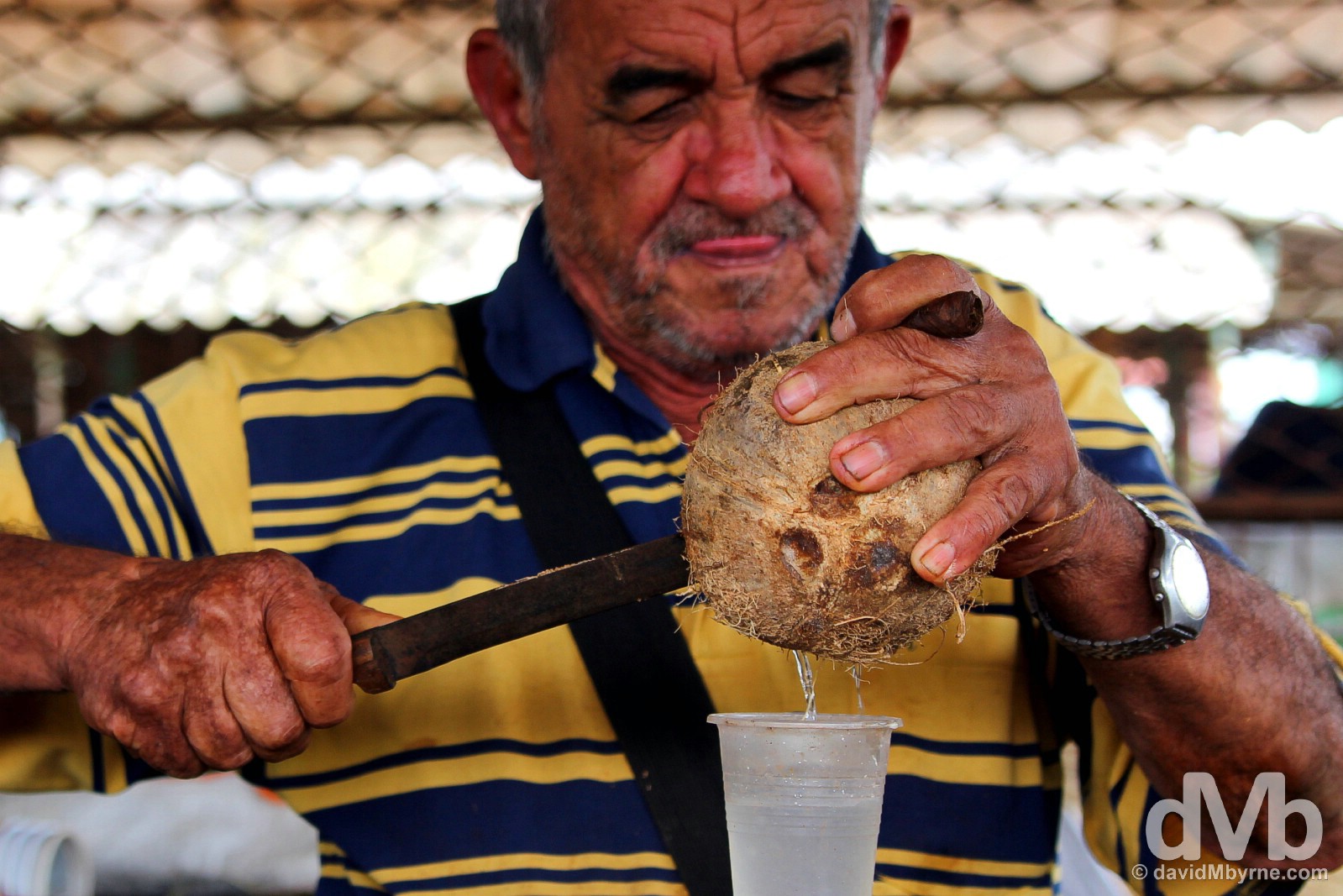
Coconut water and dirty reused plastic glasses. Mercado Agropecuario Hatibonico, Camagüey, Cuba. May 4, 2015.
• The Bus Station Staff || Drinking Cristal beers and watching the late night/early morning activity while passing time in city’s Alvaro Barba Bus Station.
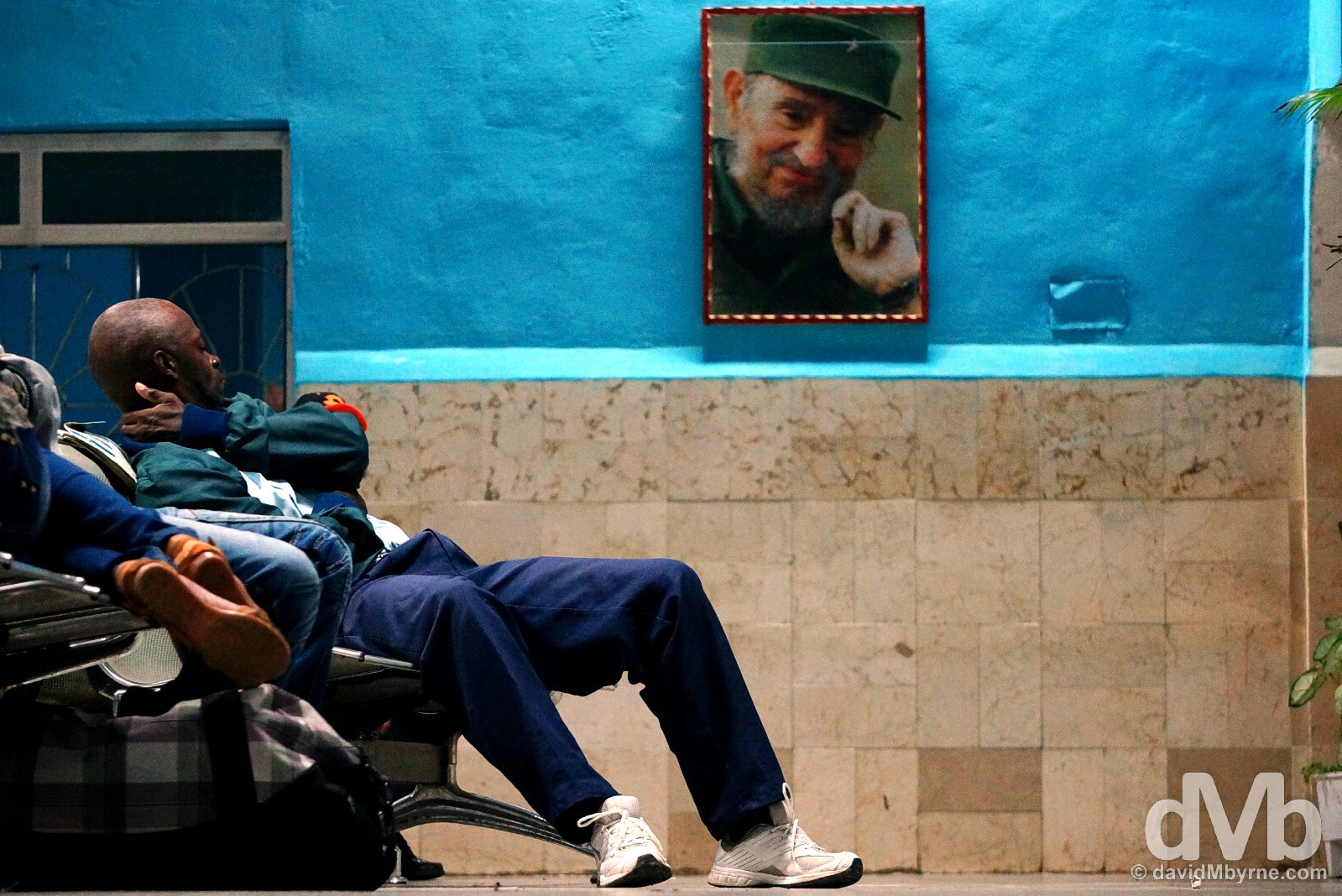
Late night/early morning in Alvaro Barba Bus Station. We arrived here earlier in the evening expecting there to be a 10 p.m. Viazul bus to Cienfuegos. There wasn’t. So we waited for the next westbound bus instead, the 2:30 a.m. Viazul bus to Trinidad, not knowing if there was available seats on the bus until the bus itself arrived. There was. Camagüey, Cuba. May 4, 2015.
Trinidad & Playa Ancon
Tourists & Touts || A riot of colonial baroque & Cuba’s most-visited location, a beguiling mid-19th-century sugar town and one of the best-preserved towns in the Caribbean.
The vast majority of travellers who see anything of Cuba outside of a Varadero resort or the capital’s Habana Vieja invariably end up in Trinidad, probably Cuba’s most idyllic, picture-postcard colonial town and the single most-visited place on the island. And with a proliferation of brightly coloured pastel-painted buildings, picturesque plazas & rambling cobbled streets, it’s not hard to understand why this one-of-a-kind UNESCO-listed town is as popular with tourists, & thus touts, as it is.

The facade of the Iglesia Parroquial de la Santisima Trinidad overlooking Plaza Mayor in Trinidad, Cuba. May 5, 2015.
– UNESCO commenting on Trinidad and the Valley de los Ingenios
My guidebook mentions that Trinidad, with all its unblemished, perfectly preserved architecture & stuck-in-time 1850s-era street scenes, is ‘ideal prowling ground for documentary photographers.’ They even provide a walking tour to guide you to the town’s many photographic highlights. I didn’t follow their tour but I did take in most of the town over the course of two days of ankle-twisting ambles along Trinidad’s gorgeous cobbled streets.

Nattering neighbours. Trinidad, Cuba. May 5, 2015.

Steep gradients & cobbled streets means Trinidad isn’t the idea place to cycle around. But some remain undeterred however much of a chore it may seem to the uninitiated. Trinidad, Cuba. May 5, 2015.
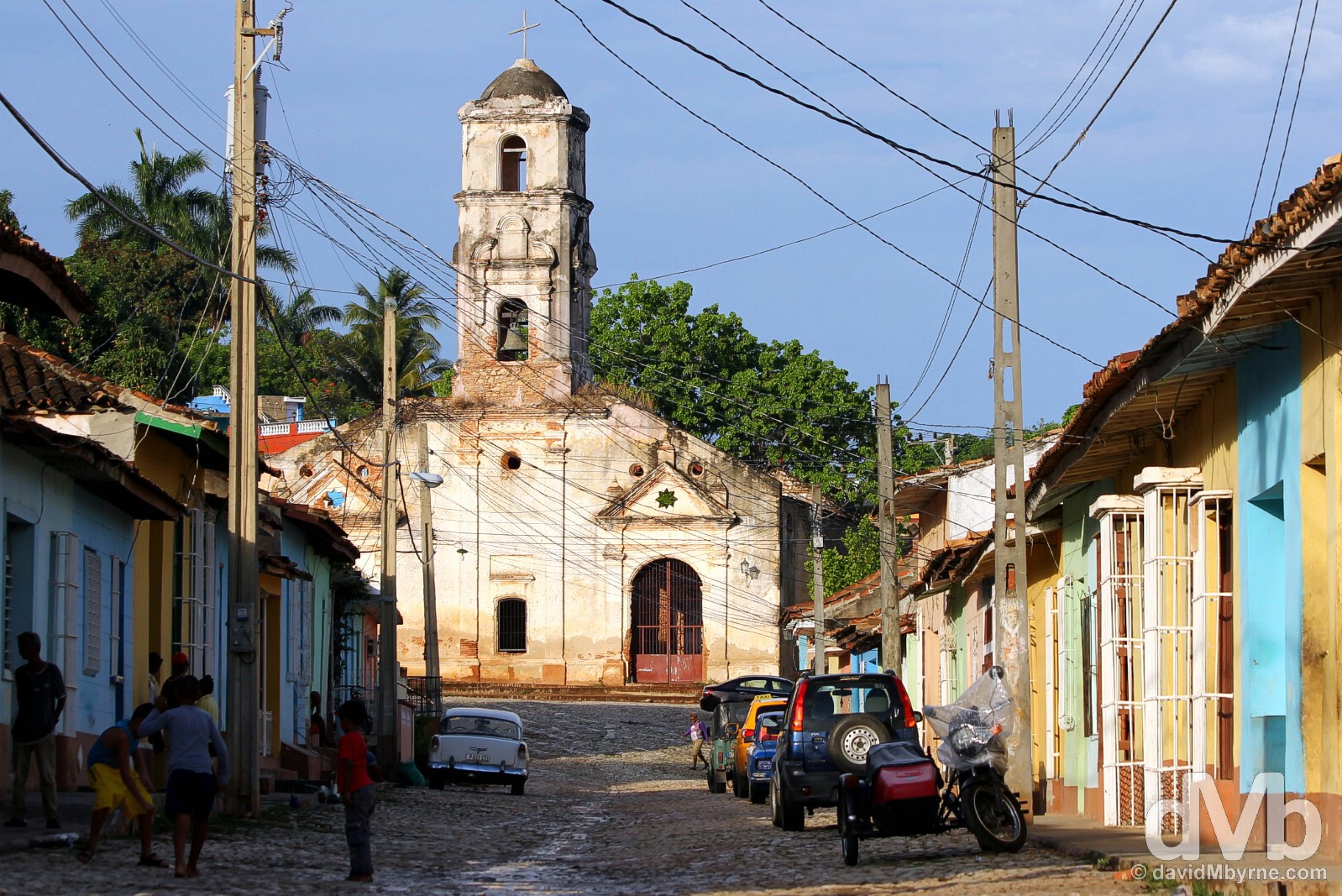
The northeastern reaches of Trinidad is the location for the ruined Iglesia de Santa Ana. Dating to 1812, today its bricked-up arched doorways are impassible and grass grows on the roof following decades of neglect. It looked beautiful in the soft light of the late evening, as much of Trinidad does. I gave this forgotten church on the town’s outskirts more attention than I did any of the immaculately-presented structures in its historic centre. Maybe that’s because getting here was so much fun, hoofing it through the seldom visited residential cobbled streets of the town. Trinidad, Cuba. May 5, 2015.

Trinidad, Cuba. May 5, 2015.

Very few cars ply Trinidad’s cobbled streets. Very few indeed. It’s mostly pedestrians & horse-drawn carriages. Trinidad, Cuba. May 5, 2015.
Playa Ancon
The best beach on Cuba’s southern coast. That’s what Playa Ancon is billed as. And being only 12 kilometres south of Trinidad makes it rather convenient to get to.

It’s not the prettiest or biggest beach in the world but it draws the Trinidad hordes. Playa Ancon, Cuba. May 6, 2015.
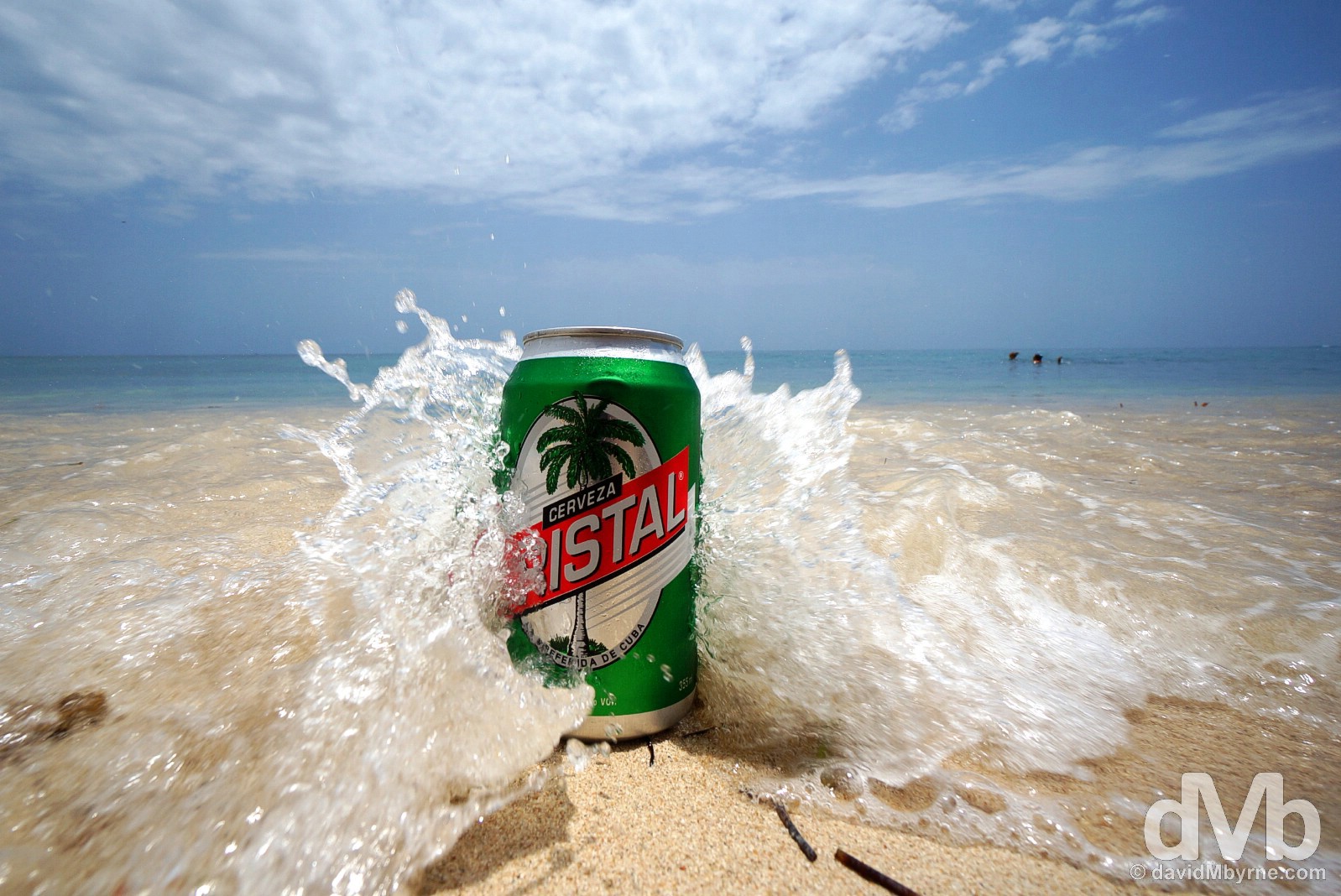
Beach beers. We hung out on the beach for a few hours lazing, reading & of course drinking some Cristal beers. It’s the only time I spent relaxing on a Cuban beach even though I spent 6 nights at the start of the trip in a beach-fronting Varadero resort. I’m just not the beach type. Playa Ancon, Cuba. May 6, 2015.

In the taxi back to Trinidad. Save for the iconic & ubiquitous restored 1950s US classic cars, most Cuban taxis are lumbering Soviet-era beasts barely fit for purpose that have been somehow pieced together over the years by whatever parts are available and/or by whatever means necessary – Cubans are said to be the world’s most ingenious mechanics and I’d well believe it. This taxi was no exception. It wasn’t pretty from the outside but things were even worse inside. Visually long since fit for the scrapheap but still today swerving to avoid the potholes in Cuba’s roads, it’s anyone’s guess as to how much life is yet left in this particular old dog. Trinidad, Cuba. May 6, 2015.

Arriving back in Trinidad, Cuba. May 6, 2015.
Some more captures from the picturesque streets of Trinidad before bidding my fellow tourist adieu and moving on to Cienfuegos, our last stop in Cuba & less than 3 hours by bus from Trinidad.

Strides & shadows on José Martí, Trinidad, Cuba. May 6, 2015.

A pit stop at a locals stand-up, street-side juice bar, of which there are many in Cuba. Prices listed here are in local-only pesos (MN, moneda nacional). In Cuba’s dual currency system, foreigners are expected to carry & buy everything only in pesos convertibles (CUC) which is pegged to the UD$ (CUC = US$ = MN25) & all of the places frequented by tourists will only list the CUC price. Of course, there’s nothing preventing tourists carrying MN, easily acquired when changing money in the ubiquitous state-run Casa de Cambios, and frequenting local-only establishments like Trinidad’s Bar La Luna where interactions with friendly Cubans are guaranteed. Trinidad, Cuba. May 5, 2015.
Cienfuegos
Porches, Columns & Spacious Elegance || French-flavoured & Cuba’s most architecturally homogeneous city, the so-called ‘Pearl of the South’ is a breezy, colourful & elegant showcase of 19th century neoclassicism.
Cuba certainly keeps things visually interesting. Nobody can ever accuse it of being boring. The Caribbean’s largest island even has a Gallic heart, one full of pastel-coloured classical facades, graceful cupolas and refined columns. In a country renowned for its unkempt tumble-down architecture, the fresh, colourful elegance & breezy openness of French-flavoured Cienfuegos stands apart from its grittier urban counterparts.

The central cupola of the stunning silver-grey Palacio de Gobierno, the seat of the provincial government, as seen from Parque José Martí in central Cienfuegos, Cuba. May 8, 2015.
Founded in 1819 & one of Cuba’s youngest cities, Cienfuegos is more French than Spanish. The elegant bay-side city, dubbed the ‘Pearl of the South’, is an astonishing architectural monument to 19th century neoclassicism, a homogeneous cityscape laid out in the early 19th century by settlers from France. The city’s urban core, centered around its delightful Parque José Martí, was inscribed on UNESCO’s World Heritage list in 2005.
– UNESCO commenting on the Urban Historic Centre of Cienfuegos

Passing time in Parque José Martí, Cienfuegos, Cuba. May 7, 2015.
Parque José Martí
There’s a different feel to life on the wide & breezy spruced-up streets of Cienfuegos. While the rest of Cuba is characteristically unkempt, Cienfuegos, with its strong industrial clout & UNESCO funds, seems to shine; the city looks and feels plusher than its island counterparts. While the whole city is a joy – Cienfuegos was to be my Cuban highlight – the city’s central Parque José Martí is where you’ll find the densest collection of the eclectic 19th-century architecture that the city is renowned for.
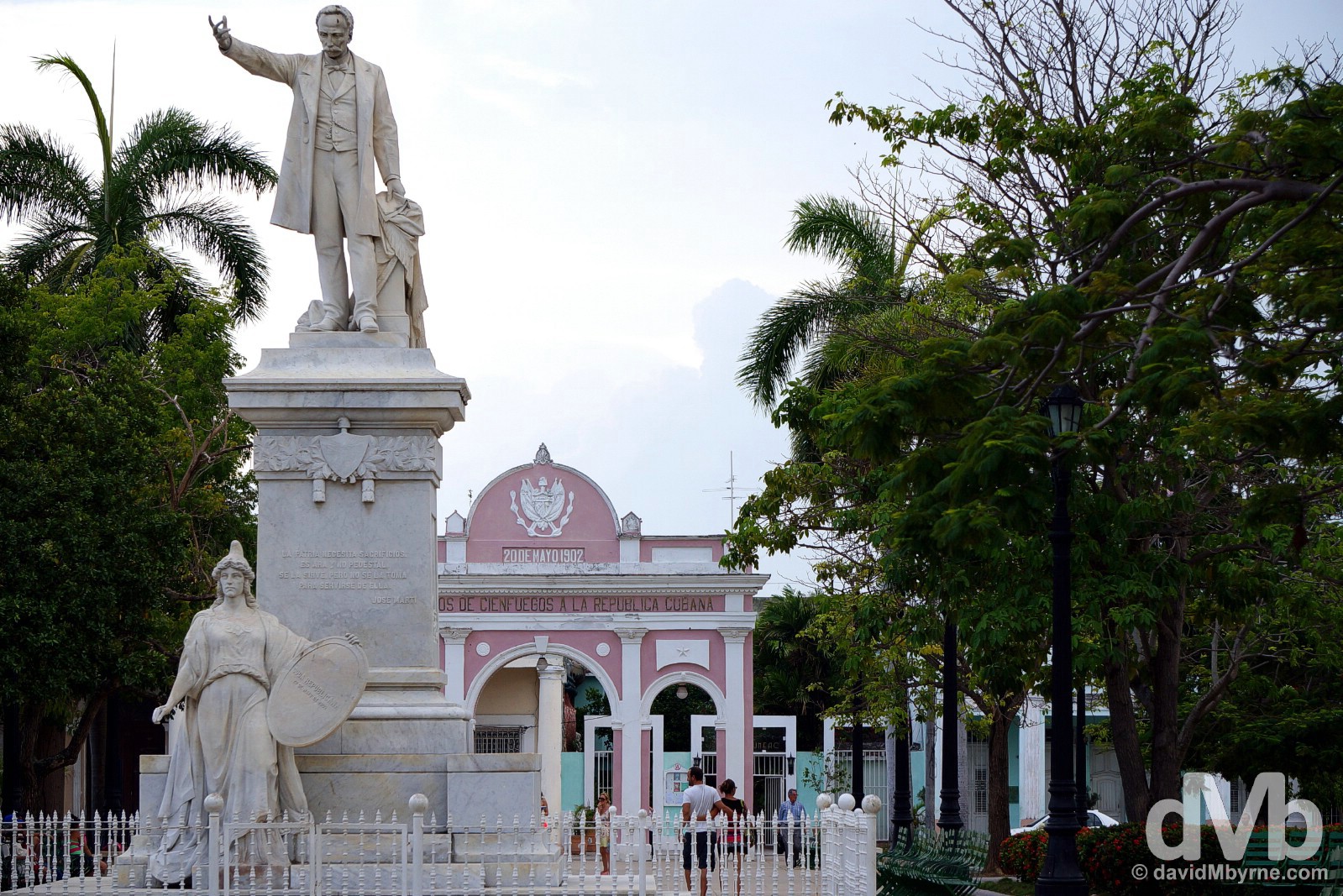
The ubiquitous José Martí statue & the Arco de Triunfo in Parque José Martí, central Cienfuegos, Cuba. May 7, 2015. || Cuba has thousands of the same José Martí statue; nearly every square is every city or town is centrally adorned by the same pose of the great man with his right arm outstretched. Born in Havana in 1853, Martí is a Cuban national hero, a revolutionary, political activist & philosopher who dedicated his life to the promotion of liberty, political independence for Cuba, and intellectual independence for all Spanish Americans; his death was used as a cry for Cuban independence from Spain by both the Cuban revolutionaries and those Cubans previously reluctant to start a revolt. Sharing the park with Martí is the distinctive pink Arco de Triunfo. Cuba’s only triumphal arch, it is a Francophile monument to Cuban Independence – May 20 1902 is the date Cuba gained formal independence from the US.
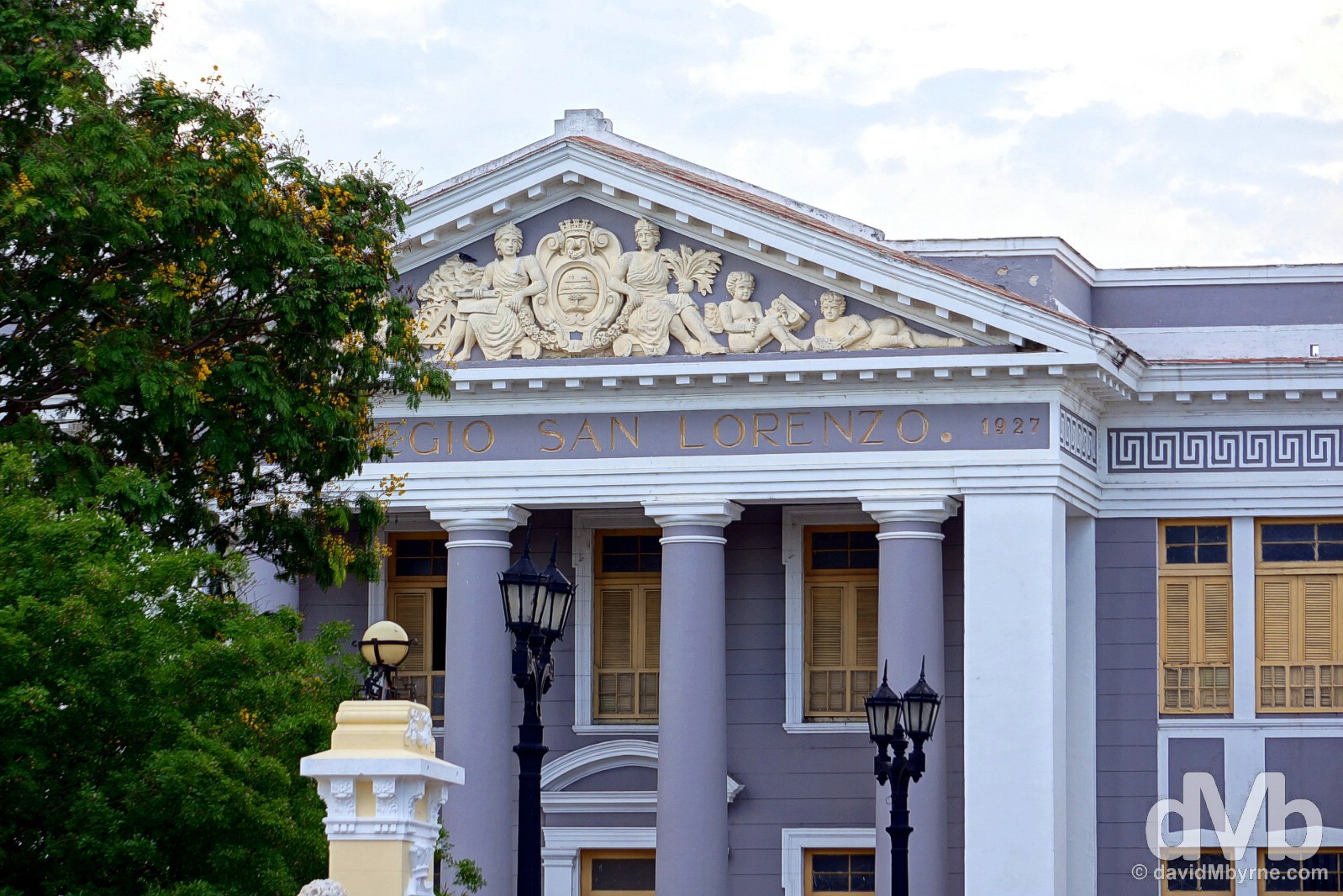
The purple colonnaded facade of the 1920s Colegio San Lorenzo as seen from Parque José Martí in Cienfuegos, Cuba. May 7, 2015.

The Casa de la Cultura Benjamin Duarte off Parque José Martí in Cienfuegos, Cuba. May 7, 2015. || While most of Cienfuegos’ surviving neoclassical buildings date from between 1850 and 1910, the city’s Casa de la Cultura Benjamin Duarte, on the southwest corner of Parque José Martí, dates to 1917. Something of a trendsetter, it was one of the city’s first buildings to sport a decorative rooftop lookout, in this case a vertigo-inducing corner cupola that wouldn’t look out of place replicated on a wedding cake.
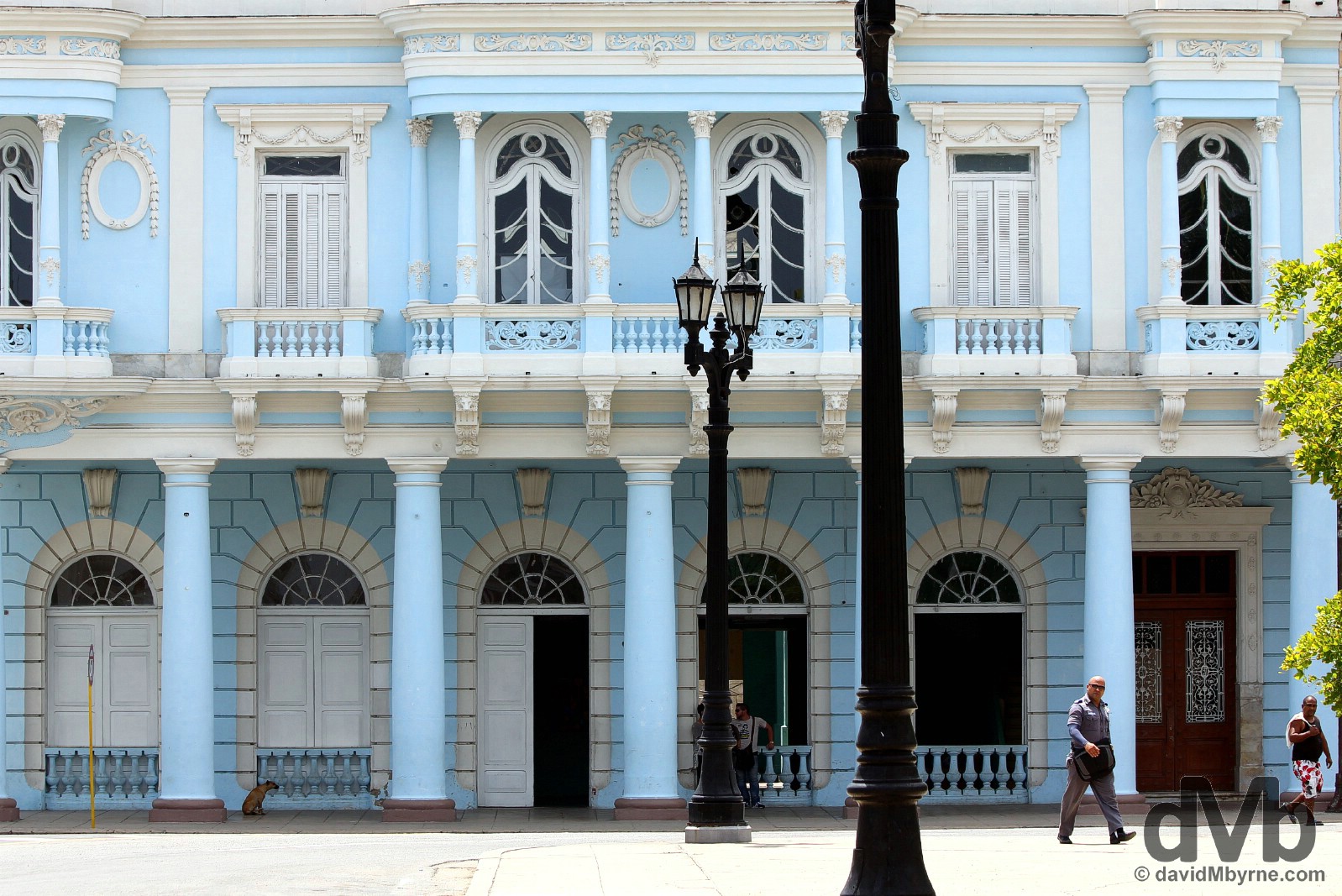
Fronting the Casa de la Cultura Benjamin Duarte in Cienfuegos, Cuba. May 8, 2015.

Parque José Martí, Cienfuegos, Cuba. May 8, 2015.

The Catedral de la Purisima Concepcion Cienfuegos on the northeastern corner of Parque José Martí, Cienfuegos, Cuba. May 8, 2015.

A section of the colonnaded Paseo del Prado in Cienfuegos, Cuba. May 8, 2015. || Cienfuegos is laid out on a wide, paved numbered grid of streets – streets go north to south, avenues east to west. This is Cienfuego’s Parisian-style main drag, Calle 37, a.k.a. El Prado, a dead-straight, 3 kilometre-long exhibit of well-proportioned colonnaded facades painted in an array of pastel colours.
– Benny Moré in the song Cienfuegos

The Benny Moré statue on El Prado, Cienfuegos, Cuba. May 8, 2015. || I agree with Benny. Cienfuegos is also the Cuban city I like the best. Benny Moré was a famous Cuban singer and the country’s most adaptable and diverse musician, ruling the country’s clubs and dance halls in the ‘40s & ‘50s. Even though he was born in a small village about 25 kilometres away, the city of Cienfuegos likes to claim him as one of their own. It has even immortalised him with this statue in the leafy pedestrianised centre of El Prado, one of the city’s non-architectural must-sees.

On the streets of Cienfuegos, Cuba. May 8, 2015.

Neighbours. Waking to a new day after yet another late Cienfuego’s night. Liam and I had a lot of fun in Cienfuegos. Maybe too much fun. Waking to our last morning in the city (or it might have been afternoon by this stage) was a chore, not helped by the fact that we were coming to the end of our time in the country & were due to get the bus back to Havana later in the day. I emerged onto the balcony of our casa particular room on this day to be warmly acknowledged by this sweet old lady manning her balcony next door. She was just the latest in a long line of friendly Cubans I interacted with while in the country. Overlooking Calle 31 in central Cienfuegos, Cuba. May 9, 2015.
The Complete Cuba Gallery
- The central cupola of the Palacio de Gobierno as seen from Parque Jose Marti in Cienfuegos, Cuba. May 8, 2015.
- Snoozing on the weathered streets of Havana, Cuba. April 30, 2015.
- Late night/early morning. Waiting on the 2:30 a.m. bus to Trinidad in Alvaro Barba Bus Station, Camaguey, Cuba. May 4, 2015.
- A section of the colonnaded Paseo del Prado in Cienfuegos, Cuba. May 8, 2015.
- Camaguey, Cuba. May 4, 2015.
- On the streets of Trinidad, Cuba. May 5, 2015.
- Restored buildings overlooking Plaza Vieja in Habana Vieja/Old Havana, Havana, Cuba. April 30, 2015.
- Museo de la Revolucion, The Museum of the Revolution, Havana, Cuba. May 2, 2015.
- Museo de la Revolucion, The Museum of the Revolution, Havana, Cuba. May 2, 2015.
- Trinidad, Cuba. May 5, 2015.
- Over half a century of neglect. San Ignacio, Habana Vieja/Old Havana, Havana, Cuba. April 30, 2015.
- Centro Habana, Cuba. May 1, 2015.
- Teniente Ray, Havana, Cuba. April 30, 2015.
- 1950s Americana on Prado (Paseo de Marti) in central Havana, Cuba. April 30, 2015.
- Plaza de los Trabajadores, Camaguey, Cuba. May 4, 2015.
- Casa de la Cultura Benjamin Duarte, Cienfuegos, Cuba. May 8, 2015.
- Cristal beer. Playa Ancon, Cuba. May 6, 2015.
- The Jose Marti statue & the Arco de Triunfo, Cuba’s only triumphal arch in Parque Jose Marti, Cienfuegos, Cuba. May 7, 2015.
- Down by the Malecon in Vedado, Havana, Cuba. May 1, 2015.
- On the streets of Cienfuegos Cuba. May 8, 2015.
- Mopping the floor of the bus station in Santa Clara, Cuba. May 3, 2015.
- Musicians in Habana Vieja/Old Havana, Havana, Cuba. May 2, 2015.
- Parque Jose Marti, Cienfuegos, Cuba. May 8, 2015.
- Maceo, Camaguey, Cuba. May 4, 2015.
- Iglesia de Santa Ana, Trinidad, Cuba. May 5, 2015.
- Cienfuegos, Cuba. May 8, 2015.
- Trinidad, Cuba. May 6, 2015.
- Overlooking Calle 31 in Cienfuegos, Cuba. May 9, 2015.
- A section of the facade of the Gran Teatro de la Habana & scaffold-covered central dome of El Capitolio in central Havana, Cuba. April 30, 2015.
- The iconic Che Guevara mural on the Ministerio del Interior building off Plaza de la Revolucion/Revolution Square in Vedado, Havana, Cuba. May 1, 2015.
- Cienfuegos, Cuba. May 8, 2015.
- The purple facade of Colegio San Lorenzo as seen from Parque Jose Marti in Cienfuegos, Cuba. May 7, 2015.
- Camaguey, Cuba. May 4, 2015.
- Jose Marti, Trinidad, Cuba. May 6, 2015.
- Playa Ancon, Cuba. May 6, 2015.
- On the streets of Havana, Cuba. April 30, 2015.
- On the cobbled streets of Trinidad, Cuba. May 5, 2015.
- Parque Jose Marti, Cienfuegos, Cuba. May 7, 2015.
- Taxi. Trinidad, Cuba. May 6, 2015.
- The wave-bashed Malecon in Havana, Cuba. May 1, 2015.
- Fresh coconut milk and dirty reused plastic glasses. Mercado Agropecuario Hatibonico, Camaguey, Cuba. May 4, 2015.
- Republica, Camaguey, Cuba. May 4, 2015.
- Cienfuegos, Cuba. May 8, 2015.
- The Casa de la Cultura Benjamin Duarte off Parque Jose Marti in Cienfuegos, Cuba. May 7, 2015.
- Camaguey, Cuba. May 4, 2015.
- The wave-bashed Malecon in Havana, Cuba. May 1, 2015.
- On the streets of Trinidad, Cuba. May 5, 2015.
- Sitting on the walls of the Malecon fronting Castillo de San Salvador de la Punta in Havana, Cuba. April 30, 2015.
- Museo de la Revolucion, The Museum of the Revolution, Havana, Cuba. May 2, 2015.
- Centro Habana/Havana, Cuba. May 1, 2015.
- Plaza de la Caterdral, Habana Vieja/Old Havana, Havana, Cuba. May 2, 2015.
- Havana, Cuba. May 1, 2015.
- On the cobbled streets of Trinidad, Cuba. May 5, 2015.
- Bar La Luna, Trinidad, Cuba. May 5, 2015.
- Chris & Liane’s wedding. Breezes Bella Costa resort, Varadero, Cuba. April 27, 2015.
Caribbean Island Hopping || Cuba To Grand Cayman, Cayman Islands
It took a bit of convincing, a little sweet-talking & the utterance of a promise, both at the check-in desk and in the Cayman Airways supervisor’s office. For a while it looked like they weren’t going to allow us board the flight to Grand Cayman, an overnight layover en route to Kingston, Jamaica. The problem was we didn’t have a confirmed flight out of Jamaica, a wrong that the aforementioned layover & the internet access the Cayman Islands boasts but Cuba doesn’t would give us the opportunity to right. That, and our word that we would indeed book a flight out of Jamaica before leaving Grand Cayman (we did), eventually saw us getting the green light to bid Cuba adios. But it was touch and go.




